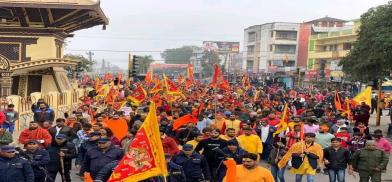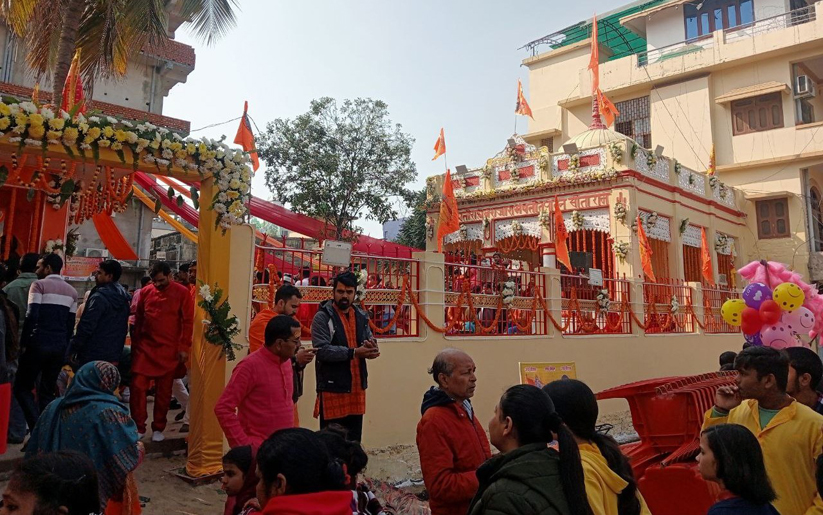India’s Ram Mandir consecration sparks celebrations, yet raises questions in Nepal
The way this was done raises questions about whether Hindus have been spiritually awakened and also what this means for India as an avowedly secular, democratic country.

Days before India's Republic Day on 26 January, the theatrical consecration of the idol of a Hindu deity demonstrating the ‘reclaiming' of the land at the ancient city of Ayodhya to build the Ram Mandir has further tarnished the country's image as the world’s largest and oldest democracy.
The ‘pran pratishtha’ or consecration of an idol of Lord Ram was carried out with fanfare on 22 January 2024 at the inauguration of the Ram Mandir which is being portrayed as India's ‘National Temple’ in Ayodhya. Indian Prime Minister Narendra Modi, standing for a third term in office, together with officials of the Bharatiya Janata Party (BJP) government, the Rastriya Swayamsewak Sang (RSS) and other Hindu leaders in India led the ceremony.
Hindu devotees believe Ayodhya was the birthplace of Lord Ram, the main character of the Ramayan, the Hindu epic and an incarnation of Lord Vishnu, one of the gods of the Hindu Trinity. According to Hindu belief, Lord Vishnu descended to earth as Ram to combat evil forces during the Treta Yug, the third world age.

Nepal’s celebrations
Hindus around the world, including in Nepal, watched or joined this ostentatious inauguration. Formerly the only Hindu kingdom, Nepal has since 2008 been a federal republic. Like India, its secular Constitution respects all religions equally.
On the day of the Ram consecration in Ayodhya, Nepalis around the country were glued to the live broadcasts run by Indian and Nepali TV channels. Many attended rituals at their local temples, with the biggest celebrations taking place at the lit-up Ram Janaki Mandir in Janakpur. This city in eastern Nepal is believed to be the birthplace of Sita, Ram’s wife, another major character of the Ramayan, and the incarnation of Vishnu's consort Laxmi.
Nepali political and religious leaders along with Ram devotees travelled to Ayodhya for the event. As the city of Lord Ram's in-laws, Janakpur sent offerings to Ayodhya, upholding the tradition of a bride's family sending gifts to the groom's household. These offerings, locally known as Bhaar, included jewellery, food, and clothes, and were ceremoniously carried to Ayodhya from Janakpur.
While Deepawali or Diwali, the festival of lights, is traditionally celebrated in the autumn months, the Ram temple inauguration in Ayodhya was also termed Deepawali. Devotees in Janakpur and various parts of Nepal including the capital Kathmandu and the plains bordering India like the industrial town of Birgunj participated fully in this celebration.
The Janaki Sena, a Hindu youth group in Janakpur, collected donations in the form of oil, cotton wicks, clay pots for the 2,50,000 oil-fed lamps (diya) they lit in Janakpur during the consecration of the idol of Ram at Ayodhya. For this, they had collected some 2,500 litres of mustard oil, which is also used for cooking.
Devotees in India had collected a thousand tonnes of sand from different shaktipiths, sacred religious sites, around the country and from Nepal for the world’s largest diya being lit for Ram’s consecration.
This earthen diya, also known as Dashrath Deepak, has a circumference of 100 meters. It took several oil tankers to burn the wick, made of many quintals of cotton.
Questions raised
But voices from different sectors also protested the huge theatrical ceremony. The main objection was about the political agenda of the BJP and RSS, that places Hindutva, or right-wing Hindu ideology, at the front and centre of the BJP campaign for the upcoming elections in 2024. The demonstration of power at the ceremony and the Hindutva frenzy whipped up is expected to ensure a BJP victory for the third term.
A joint statement on the day of the inauguration by 22 Indian diaspora organisations termed the ceremony a “dangerous precedent” and "a signal that India has moved to the brink of implementing the long-term RSS goals of making India a Hindu Rashtra (state) and replacing the constitution with Manusmriti, a violently Brahminical anti-Dalit and patriarchal ancient Hindu text.”
There were also objections to the consecration ceremony taking place before the temple construction was completed. Several priests known as Shankaracharyas, the guardians of the Hindu religion, refused to participate, protesting that the due process of the rituals was not followed.
India still has a secular Constitution and holds elections regularly, earning itself the label of the world's largest democracy. The overtly religious ceremony of a grand ‘National Temple’ counters this image.
Prime Minister Modi's role at the forefront of the inauguration has obliterated the “principled distance” between the state and the religion as set out in India’s foundation as a secular nation.
There are also concerns about Hindu nationalist groups ‘appropriating’ Muslim religious sites. The Indian Supreme Court’s 2019 verdict allowed a Ram temple to be built on the site where the Babri Masjid had stood, demolished by the Hindu vigilantes in 1992. The right-wing Hindu lobby is now also laying claim to other Muslim places of worship, in cities like Varanasi and Mathura.
While many celebrities, political leaders and thousands of ordinary people joined the consecration ceremony, some were conspicuous by their absence, like the 96-year-old veteran BJP leader LK Advani and veteran BJP leader Murli Manohar Joshi, besides the main opposition leaders.
Former Indian Deputy Prime Minister Advani had actually led the Ram Janmabhoomi (Ram’s birthplace) movement in the 1990s, starting with a rath yatra (chariot journey) that culminated in the demolition of the Babri Masjid on 6 December 1992.
The BJP was founded in 1980 with Advani taking the leadership of the Ram Janmabhoomi movement in 1984 before becoming party president in 1986. The BJP has thus long had this agenda, now realised by PM Modi.
The way this was done raises questions about whether Hindus have been spiritually awakened and also what this means for India as an avowedly secular, democratic country.
(The author is a senior journalist and women rights advocate in Nepal. She is also an active member of the Sapan News Advisory Council. Views are personal. By special arrangement with Sapan News)
got much clear idea on the topic of from this paragraph.
but you seem like you know what you're talking
about! Thanks
compatibility problems. Whenever I take a look at your website
in Safari, it looks fine however, when opening in Internet Explorer, it
has some overlapping issues. I just wanted to give you a quick heads up!
Other than that, great website!
I feel that you just can do with some % to drive the message home a bit,
but instead of that, that is great blog. A great read.
I will certainly be back.
Некоторое время назад мне потребовалось купить инверторный кондиционер,
и мне рекомендовали на сайт ТопКлиматДВ.рф.
Мне впечатлил большой ассортимент сплит систем.
Советы специалистов содействовали
мне сделать правильный выбор какую сплит систему купить.
Цены приемлемые, и более того
можно заказать установку. Мне было приятно отношение, и могу
посоветовать этот сайт каждому, кто собирается купить кондиционер.
Всего наилучшего!
piece of writing here at this website, I have read all that, so at this time me also commenting at this place.
There's a lot of folks that I think would really enjoy your content.
Please let me know. Cheers









Post a Comment